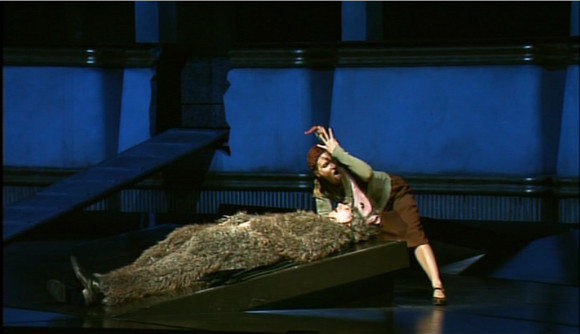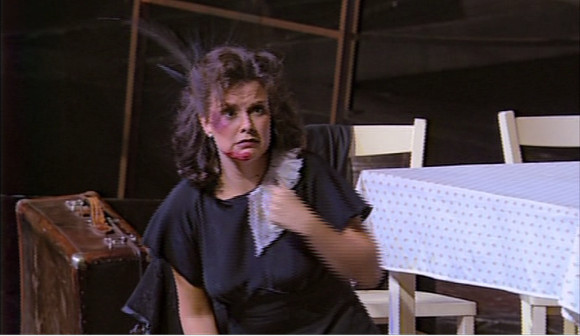It’s really hard to know where to start with Hans Neuenfels’ Die Fledermaus. It’s a prodcuction that enraged the more conventional patrons when it opened at the Salzburg Festival in 2001. It even provoked a “false pretences” lawsuit! There is so much going on that it almost seems to call for a catalogue raisonnée of the various scenes though one fears that would actually be both tedious and unhelpful. Let’s try instead to explore it thematically. Neuenfels takes very considerable liberties with the libretto. A lot of dialogue is cut, a lot is added and numerous non-canonical characters are inserted. That’s just a start.
 The overture plays out the Falke/Eisenstein back story in dance. Falke’s prominent bat proboscis is sexually indulged in assorted ways by the female dancers. Here’s the first obvious theme. There’s a lot of sex in this production but nobody is enjoying it much. Then we meet the Eisenstein family. There’s a lot of repressed violence. The Eisenstein children, the first of many interlopers, come over rather like Hänsel and Gretel in a rather grim production. The family seems completely dysfunctional in an entirely conventional bourgeois way. Does it in fact stand for the Patriarchy? Later “Gretel” will get felt up by her father and raped by her brother. In the last scene of Act 3 “Hänsel” shoots first “Gretel”, then himself. In between they don’t have much fun.
The overture plays out the Falke/Eisenstein back story in dance. Falke’s prominent bat proboscis is sexually indulged in assorted ways by the female dancers. Here’s the first obvious theme. There’s a lot of sex in this production but nobody is enjoying it much. Then we meet the Eisenstein family. There’s a lot of repressed violence. The Eisenstein children, the first of many interlopers, come over rather like Hänsel and Gretel in a rather grim production. The family seems completely dysfunctional in an entirely conventional bourgeois way. Does it in fact stand for the Patriarchy? Later “Gretel” will get felt up by her father and raped by her brother. In the last scene of Act 3 “Hänsel” shoots first “Gretel”, then himself. In between they don’t have much fun.
 Then there’s the female Frosch who appears at odd moments spouting apparently random verse. There’s a particularly poignant piece about baby rats in a corpse. And she gets to beat up Adele in Act 3. The take on Orlofsky is quite extreme too. He’s a coke addled rasta who doesn’t really sing. Rather he grunts and squeals in an extremely peculiar manner. He’s right on the edge and has to be fed pills by Falke. If Falke is an MD he’s clearly in the same mould as Michael Jackson’s physician. And so it goes on. There’s a disco and zombies at Orlofsky’s party. Nazis appear to beat up Dr. Blind. etc etc. Overall there are lots of ideas but equally many loose ends. It’s quite stimulating but also curiously unsatisfying. And there’s not a Champagne bottle or glass to be seen.
Then there’s the female Frosch who appears at odd moments spouting apparently random verse. There’s a particularly poignant piece about baby rats in a corpse. And she gets to beat up Adele in Act 3. The take on Orlofsky is quite extreme too. He’s a coke addled rasta who doesn’t really sing. Rather he grunts and squeals in an extremely peculiar manner. He’s right on the edge and has to be fed pills by Falke. If Falke is an MD he’s clearly in the same mould as Michael Jackson’s physician. And so it goes on. There’s a disco and zombies at Orlofsky’s party. Nazis appear to beat up Dr. Blind. etc etc. Overall there are lots of ideas but equally many loose ends. It’s quite stimulating but also curiously unsatisfying. And there’s not a Champagne bottle or glass to be seen.
 Musically it’s rather unbalanced too. All the men, except maybe the Alfred of Jerry Hadley, are given so much character acting to do with the voice that they don’t really get to do much singing. This is most obvious with David Moss’ Orlofsky but it also means that Christopher Homberger as Eisenstein, Dale Duesing’s Frank and Olaf Bär’s Falke are given few opportunities to show off their considerable vocal talents. The music making rests heavily on the Rosalinde and the Adele. Fortunately these roles are taken by Mireille Delunsch and Malin Hartelius who are more than capable of making the music sing when they get the chance. Hartelius,indeed, is often quite spectacular. The Frosch here is Elisabeth Thissenaar and she really does a good job of dealing with the complex series of tasks she has for she’s not just playing Frosch and reciting a lot of interpolated action she’s also a kind of Chorus commenting on the production and its relationship to the performance tradition of Fledermaus.
Musically it’s rather unbalanced too. All the men, except maybe the Alfred of Jerry Hadley, are given so much character acting to do with the voice that they don’t really get to do much singing. This is most obvious with David Moss’ Orlofsky but it also means that Christopher Homberger as Eisenstein, Dale Duesing’s Frank and Olaf Bär’s Falke are given few opportunities to show off their considerable vocal talents. The music making rests heavily on the Rosalinde and the Adele. Fortunately these roles are taken by Mireille Delunsch and Malin Hartelius who are more than capable of making the music sing when they get the chance. Hartelius,indeed, is often quite spectacular. The Frosch here is Elisabeth Thissenaar and she really does a good job of dealing with the complex series of tasks she has for she’s not just playing Frosch and reciting a lot of interpolated action she’s also a kind of Chorus commenting on the production and its relationship to the performance tradition of Fledermaus.
 Marc Minkowski conducts the Mozarteum Orchestra Salzburg. It’s a perfectly sound, conventional interpretation of the score which can’t help but come off as soundtrackish as there are so many places where music and action seem to be counterpoised rather than integrated. The Arnold Schoenberg Choir also sounds good when it has to but also gets top marks for extreme choral acting. There’s varied and excellent work from a small corps of dancers who have to mange everything from classical ballet moves to getting kicked in the nuts.
Marc Minkowski conducts the Mozarteum Orchestra Salzburg. It’s a perfectly sound, conventional interpretation of the score which can’t help but come off as soundtrackish as there are so many places where music and action seem to be counterpoised rather than integrated. The Arnold Schoenberg Choir also sounds good when it has to but also gets top marks for extreme choral acting. There’s varied and excellent work from a small corps of dancers who have to mange everything from classical ballet moves to getting kicked in the nuts.
 The video direction is by Don Kent and he does a decent job of filming a production that tends to sprawl all over the large stage and back wall of the Felsenreitschüle. He’s a bit fond of weird angles, especially shots from below but it’s not too distracting. The picture and Dolby 5.1 sound are quite adequate but not as good as the most recent HD recordings. There are no extras but the booklet contains an essay with a fun description of the unsurprising furore surrounding this production. Subtitle options are German, English, French, Spanish and Japanese.
The video direction is by Don Kent and he does a decent job of filming a production that tends to sprawl all over the large stage and back wall of the Felsenreitschüle. He’s a bit fond of weird angles, especially shots from below but it’s not too distracting. The picture and Dolby 5.1 sound are quite adequate but not as good as the most recent HD recordings. There are no extras but the booklet contains an essay with a fun description of the unsurprising furore surrounding this production. Subtitle options are German, English, French, Spanish and Japanese.
 Traditionalists should definitely stay away from this unless they feel the need for something to get indignant about. Fans of Regietheater will likely find much to like though, in the last analysis, I think it’s a production that has a lot of interesting ideas that don’t get developed into a fully coherent whole.
Traditionalists should definitely stay away from this unless they feel the need for something to get indignant about. Fans of Regietheater will likely find much to like though, in the last analysis, I think it’s a production that has a lot of interesting ideas that don’t get developed into a fully coherent whole.


I think I like Neuenfels’ work better when he deconstructs, as in Die Entführung or Lohengrin, than when he adds so much as he seems to here. I’ve not seen this whole production–Just a few YT excerpts–and I guess I’d better check it out, given the cast. But my hopes have been lowered! (But first I have to watch my Rosenkavalier discs with Stemme, Kasarova and Hartelius!)
Thanks for calling out the AS Choir. I think they ROCK in every production they’re in, especially standing out for me in Guth’s staging of Messiah, and in Chereau’s From the House of the Dead, (not to mention any concert where they get to just stand and sing!)
Neuenfels made a fantastic comeback with the Bayureuth Lohengrin and the Munich Medea in Corinto, His Fledermaus is a mess. It shows that he is an interpretator, not a creator.
I really liked his Lohengrin though that one riles the traditionalists too. Personally, I think any production of Lohengrin that doesn’t rile traditionalists probably misses the point!